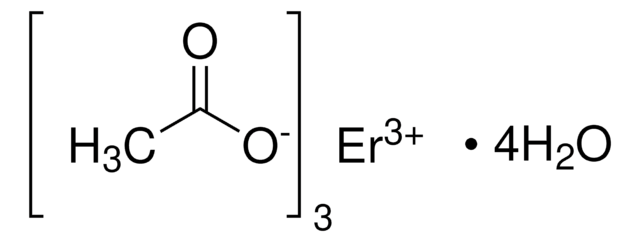544973
Ytterbium(III) acetate hydrate
99.95% trace metals basis
Synonym(s):
Acetic acid ytterbium hydrate
Sign Into View Organizational & Contract Pricing
All Photos(1)
About This Item
Recommended Products
Assay
99.95% trace metals basis
form
powder or crystals
reaction suitability
core: ytterbium
reagent type: catalyst
SMILES string
O.CC(=O)O[Yb](OC(C)=O)OC(C)=O
InChI
1S/3C2H4O2.H2O.Yb/c3*1-2(3)4;;/h3*1H3,(H,3,4);1H2;/q;;;;+3/p-3
InChI key
PHWPQNTXTCAARQ-UHFFFAOYSA-K
Application
- Highly luminescent, biocompatible ytterbium (III) complexes as near-infrared fluorophores for living cell imaging: This study highlights the development of ytterbium complexes with enhanced near-infrared luminescence suitable for live-cell imaging, utilizing Ytterbium(III) acetate hydrate as a precursor. The findings demonstrate significant potential for biomedical applications, particularly in imaging techniques sensitive to deeper tissue penetration (Ning et al., 2018).
Storage Class Code
11 - Combustible Solids
WGK
WGK 3
Flash Point(F)
Not applicable
Flash Point(C)
Not applicable
Personal Protective Equipment
dust mask type N95 (US), Eyeshields, Gloves
Certificates of Analysis (COA)
Search for Certificates of Analysis (COA) by entering the products Lot/Batch Number. Lot and Batch Numbers can be found on a product’s label following the words ‘Lot’ or ‘Batch’.
Already Own This Product?
Find documentation for the products that you have recently purchased in the Document Library.
Customers Also Viewed
Aleksandra Kiseleva et al.
ACS applied materials & interfaces, 11(26), 22962-22972 (2019-06-30)
Spider silk is a natural material possessing unique properties such as biocompatibility, regenerative and antimicrobial activity, and biodegradability. It is broadly considered an attractive matrix for tissue regeneration applications. Optical monitoring and potential control over tissue regrowth are attractive tools
Hongqi Chen et al.
Analytical methods : advancing methods and applications, 12(42), 5081-5085 (2020-10-13)
In this work, we developed a simple and selective luminescence sensing system for detecting ascorbic acid (AA) based on NaGdF4:Yb,Er@NaYF4 upconversion nanoparticles (UCNPs) and oxidase-like CoOOH nanoflakes. When p-phenylenediamine (PPD) and oxidase-like CoOOH nanoflakes were added to the UCNPs solutions
Lam Thi Kieu Giang et al.
Scientific reports, 10(1), 14672-14672 (2020-09-06)
This paper presents the use of soft template method to synthesize core and core-shell up-converting nanoparticles usefull for temperature sensing applications. Based on the stock solutions of core β-NaYF4:Er3+,Yb3+ nanoparticles and involving soft template method without any additional process of
Qianqian Su et al.
Frontiers in chemistry, 8, 836-836 (2020-10-24)
Lanthanide-based upconversion nanoparticles can convert low-energy excitation to high-energy emission. The self-assembled upconversion nanoparticles with unique structures have considerable promise in sensors and optical devices due to intriguing properties. However, the assembly of isotropic nanocrystals into anisotropic structures is a
Wei Kong et al.
Inorganic chemistry, 56(2), 872-877 (2017-01-06)
Lanthanide-doped upconversion nanoparticles with a suitable surface coating are appealing for biomedical applications. Because high-quality upconversion nanoparticles are typically prepared in an organic solvent and passivated by hydrophobic oleate ligands, a convenient and reliable method for the surface modification of
Our team of scientists has experience in all areas of research including Life Science, Material Science, Chemical Synthesis, Chromatography, Analytical and many others.
Contact Technical Service















